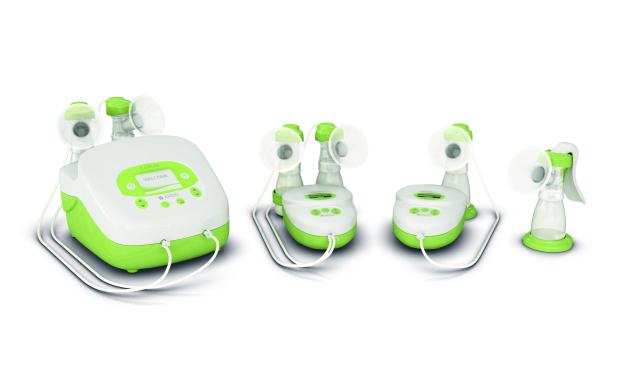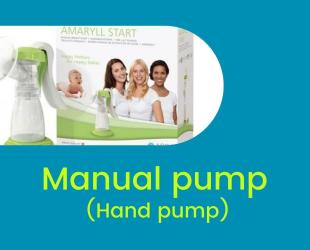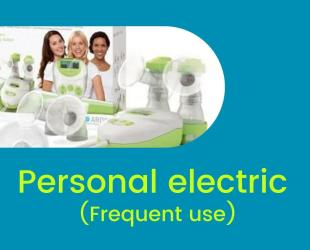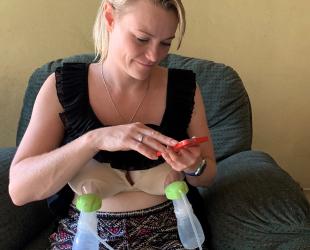Whatever your reason for expressing, there's a pump that's right for you.

Many breastfeeding mums will express their breastmilk at some stage. Sometimes it can be confusing to know which type of pump will best suit your needs.
What are your needs?
Before you buy or hire a breast pump, the first things to consider are your reasons for expressing and how often you plan to pump.
A hospital grade pump is recommended if:
your baby is unable to breastfeed yet, e.g. a premature or sick baby
you are exclusively expressing
you are returning to work and need to pump often each day
you are trying to greatly increase your supply
you are relactating or inducing lactation.
For many mums who are expressing less often or only on occasions to have some breast milk on hand, a personal electric pump or hand pump will be adequate.
You will get the most benefit from a pump that closely matches your personal circumstances.1
Helping you choose a pump
To help you with your decision, we have rated your pump options based upon:
- the length of time you might need to use a pump, e.g. days or weeks
- how frequently you might need to use a pump.
We have used these definitions:
Short term - less than 4 weeks
Long term - 4 weeks or more
Occasional use - once a day or less
Frequent use - more than once a day
The key to our star ranking:
*** Best option
** Good option
* OK option
X Not recommended
If you would like more information on choosing a breast pump, talk to your local breastfeeding volunteer. Become a member of ABA to hire a pump for half price.

Short term, occasional use ***
Short term, frequent use *
Long term, occasional use **
Long term, frequent use *
Exclusive expressing X
(not recommended)
Example Pumps:
- Ardo Amaryll Start
- Ameda One-hand manual

Short term, occasional use ***
Short term, frequent use*
Long term, occasional use ***
Long term, frequent use *
Exclusive expressing **
(once supply is established)
Example Pumps:
- Ardo Calypso Single
- Ameda Purely Yours

Short term, occasional use *
Short term, frequent use***
Long term, occasional use *
Long term, frequent use ***
Exclusive expressing **
(once supply is established)
Example Pumps:
- Ardo Calypso Double Plus
- Ardo Alyssa Double
- Ameda Purely Yours Ultra

Short term, occasional use *
Short term, frequent use***
Long term, occasional use *
Long term, frequent use ***
Exclusive expressing ***
(especially when expressing to maintain/establish a full milk supply)
Example Pumps:
- Ardo Carum
- Ameda Platinum
Breast shields
A breast shield (or breast pump flange) is the clear plastic piece that fits over your nipple. The shield forms a seal against the skin of your areola. When you express, the suction of the pump gently draws your nipple into the tunnel to extract the milk. If needed, shields can be warmed before use to help the milk to flow.2
Breast shields come in many different sizes. Using the correct size helps to ensure pumping is comfortable and you can express the most milk.3,4 Many of the women in a recent small study had improved comfort and could pump more milk when using a smaller-fit flange,5 but this won't be true for all women. The width of your nipples may also change over time so you may need to change your shields.
Finding the right size shield
- Measure the width of the tip of your nipple and choose shields the same size or 1 to 2mm bigger.
- Check if the size of your shields is correct by looking at how your nipple fits into the tunnel of the breast shield when you pump. Your nipple should fit closely in the tunnel but move freely and easily:
- If your nipple rubs against the sides, the breast shield is too small. Pumping may be painful and cause nipple soreness or damage. Try a larger size.
- If your areola is pulled into the tunnel with your nipple, or milk leaks from the bottom of the shield, it is too large. This may cause pain at the base of the nipple. Try a smaller size.
If you are having problems finding the right fit, speak to your midwife, lactation consultant or a breastfeeding counsellor.
Wearable pumps
Wearable pumps are small pumps that fit inside your bra and allow you to move about freely. Once set up they are designed to be hands-free and discreet.
There isn't much research on wearable pumps, but some women find them helpful when they return to work or study.7-9 They may not always remove the milk well enough to maintain your supply unless you are also breastfeeding your baby directly or using another good-quality pump. For this reason, they may be best used once you have a good milk supply.
- Meier, P. P., Patel, A. L., Hoban, R., & Engstrom, J. L. (2016). Which breast pump for which mother: An evidence-based approach to individualizing breast pump technology. Journal of Perinatology, 36(7), 493–499. https://doi.org/10.1038/jp.2016.14
- Kent, J. C., Geddes, D. T., Hepworth, A. R., & Hartmann, P. E. (2011). Effect of warm breastshields on breast milk pumping. Journal of Human Lactation, 27(4), 331–338. https://doi.org/10.1177/0890334411418628
- Becker, G. E., Smith, H. A., & Cooney, F. (2016). Methods of milk expression for lactating women. The Cochrane Database of Systematic reviews, 9(9), CD006170. https://doi.org/10.1002/14651858.CD006170.pub5
- Eglash, A., & Malloy, M. L. (2015). Breastmilk expression and breast pump technology. Clinical Obstetrics and Gynecology, 58(4), 855–867. https://doi.org/10.1097/GRF.0000000000000141
- Anders, L. A., Mesite Frem, J., & McCoy, T. P. (2024). Flange size matters: A comparative pilot study of the Flange FITSTM Guide versus traditional sizing methods. Journal of Human Lactation, 8903344241296036. Advance online publication. https://doi.org/10.1177/08903344241296036
- Jackson, B. A., Pawlowski, C. M., Weiner, G. M., Sturza, J., & Stanley, K. P. (2020). Interchanging breast pump kit brands alters breast pump suction pressure. Breastfeeding Medicine, 15(2), 79–83. https://doi.org/10.1089/bfm.2019.0153
- Sheffield, V., Tomlinson, S., McCaffery, H., & McCormick, A. D. (2024). One pump at a time: A wearable lactation pump pilot for graduate medical education trainees. Breastfeeding Medicine, 19(11), 885–888. https://doi.org/10.1089/bfm.2024.0134
- Colbenson, G. A., Hoff, O. C., Olson, E. M., & Ducharme-Smith, A. (2022). The impact of wearable breast pumps on physicians' breastfeeding experience and success. Breastfeeding Medicine, 17(6), 537–543. https://doi.org/10.1089/bfm.2021.0266
- McMillin, A., Behravesh, B., Byrne, P., & Unruh, G. K. (2021). A GME wearable breast pump program: An innovative method to meet ACGME requirements and federal law. Journal of Graduate Medical Education, 13(3), 422–423. https://doi.org/10.4300/JGME-D-20-01275.1
© Australian Breastfeeding Association January 2025


